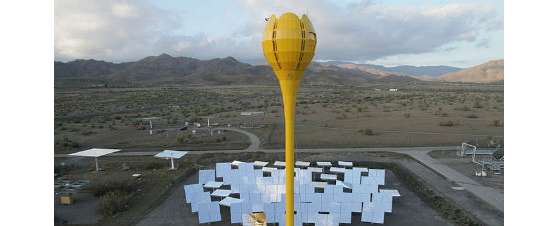They look like something commissioned by the Museum of Modern Art: 115-foot-high yellow tulip-shaped sun collectors designed by AORA, a solar energy innovator from Israel.
With about 50 tracking mirrors focusing the sun’s rays onto it, the solar “tulip” generates electricity using ultra-high temperature concentrating solar power (CSP) technology.
AORA, which started generating solar power in Israel in 2009, will dedicate its second demo power plant in February in Almeria, Spain, on a half-acre plot of land at the Platforma Solar Almeria science park. It is hoped to serve as a point of entry into the European market and beyond.
The system uses giant yellow solar receivers fitted with 100-kilowatt gas turbines, which heat air to about 1,000 degrees Celsius using the sun’s energy, directing the heated air to a turbine that then converts thermal energy to electric energy.
A hybrid system
The new installation in sunny Spain will provide 100 kilowatts of electric power to the grid, as well as 170 kilowatts of thermal power, enough to supply 50 average households. The idea is to build clusters of these plants in order to achieve big numbers in energy production.
It’s a hybrid system, meaning that when available sunlight is not sufficient, it can operate on any alternative fuel source in order to guarantee an uninterrupted power supply.
The first AORA power station, in Israel’s southern Kibbutz Samar, is still providing power to the grid since it was turned on in 2009.
A flower-power garden
Zev Rosenzweig, the CEO of AORA, tells ISRAEL21c that the Spanish deal could open up business in the Italian market nearby – and eventually, much farther afield.
Since Spain is already a solar energy leader, that was the easiest market to enter, he explains. “We hope to have one dozen [plants] in the southeast United States by end of 2012,” he says, “as well as a number of plants in Mexico, our primary focus for the next two years.”
Demonstration plants help the company achieve bankability and financing, he points out.
A migrant to renewables from the nuclear industry, Rosenzweig admits that at first blush it seems that the kilowatts of power promised by AORA pale in comparison to megawatt systems, like the BrightSource CSP plant in California that deflects sunlight from its mirrors, or heliostats, to a high tower where they turn turbines to generate electricity.
But the premise behind AORA, conceived in the Weizmann Institute of Science lab of Prof. Jacob Karni in the 1980s, is to avoid losing energy in the usual CSP process as the sun’s rays travel through the air.
By building the collection station close to the mirrors, and by building the plants close to or on the grid, more power is retained. “Our philosophy is to have many small units, each highly efficient, and close to the tower,” says Rosenzweig.
Small investment, high returns
Rather than billions, a half million dollars can build a solar plant to power roughly 50 homes in Europe, and a few fewer in the United States where consumption is higher. Hooked up together, a “flower garden” of AORA plants could power entire cities, or simply feed their power back to the grid as they are currently built to do. Off-grid solutions, though, are possible.
AORA stations do not need to be built on flat surfaces like the deserts of California. And because they are small, clusters of them can be built around wildlife corridors instead of through them. This could help avoid clashes with environmentalists looking to protect open space for wildlife.
Requiring less water to run than do larger systems, less downtime for maintenance — since only one unit of the plant needs to go offline at a time instead of a whole large plant — and the fact that it can run on hybrid mode, make AORA’s a flexible and reliable system for both remote and green communities.
AORA is based in Rehovot, Israel, and together with its staff in Spain employs 18 people. About $25 million has been invested to date; the company seeks an additional $25 to 30 million. The company was founded in 2008 and has private shareholders as well as a major shareholder, EDIG.

















